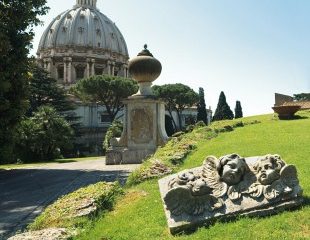Vatican Gardens

Vatican Gardens
The Vatican Gardens extend over an area of approximately 22 hectares, corresponding to half of the entire territory of Vatican City. They date back to the time of the learned Pope Nicholas III (1277-1280), who had a viridarium built on Mons Saccorum, in the northern part of the state. This large walled garden, comprising expanses of lawns and wooded areas, also included vineyards and a flourishing fruit and vegetable garden. In addition to a wide variety of beautiful plants and medicinal herbs, it was also home to numerous animal species, including exotic specimens, which, together with the crops, ensured a constant supply of food for the Pope's table. The wooded area and meadows populated with animals also offered the possibility to organise hunting parties. From the end of the fifteenth century the garden was further enriched thanks to some architectural interventions, such as the Belvedere “palace of delights” built by Pope Innocent VIII Cybo (1484-1492), a place of rest with an extensive view of Rome, or the project designed by Donato Bramante (1444-1514) on behalf of Pope Julius II della Rovere (1503-1513) for a large courtyard, also called “Belvedere”. By 1565 the inventive architect Pirro Ligorio (1512/13-1583) had built the Casina with loggia for Pius IV Medici di Marignano (1559-1565), which took its name from that pontiff, masterfully inserting it into the Vatican's green area, not far from the Apostolic Palace. The garden area was further expanded by the next pope, Pius V Ghislieri (1566-1572), with the addition of exotic and rare plants collected by the botanist Michele Mercati and the Bolognese scholar Ulisse Aldrovandi, who added them to the many rare specimens sent as gifts to the pope from all over the world. Mercati also created beautiful flowerbeds and colourful hedges arranged in intricate geometric designs, in keeping with the spectacular fashion of Italian gardens at the time.
In the early years of the seventeenth century, Pope Paul VI Borghese (1605-1621) took care to plant a wide variety of trees, plants and flowers in the gardens, sometimes rare and sought-after species from all over the world, creating a colourful botanical catalogue. The providential restoration of Trajan's aqueduct enabled numerous fountains to be added, with sculptural and scenographic forms, to irrigate the entire green area with lively jets and water features.
At that time the green area of the Vatican already extended beyond the Leonine Walls, where large cultivated fields and areas dedicated to the grazing of animals constituted a thriving farm capable of production for sale.
At the end of the eighteenth century, Napoleon's troops plundered much of the Vatican Gardens, destroying large areas of greenery. A few decades later, Pope Gregory XVI Cappellari (1831-1846) showed a keen interest in the Gardens, commissioning numerous projects and renovation and decorative works, which are described in detail by the scholar Gaetano Moroni, a papal dignitary and close collaborator of the Pope, in his monumental Dizionario di erudizione storico-ecclesiastica (Dictionary of Historical and Ecclesiastical Scholarship, 1840-1861). Gregory XVI was also responsible for the redevelopment of what had been Pope Farnese's secret garden (1534-1549) with flower beds and lush citrus espaliers. During the nineteenth century and beyond, in the wake of the romantic fashion for English gardens, the network of paths intersecting the wooded area was embellished with ancient and modern sculptures scattered among the plants and trees. These works include the marble statue of Saint Peter in chains, by the Florentine sculptor Maria Luisa Amalia Dupré (1842-1928), donated in 1887 by the Congregation of the Pious Schools of the Piarist Order to Pope Leo XIII Pecci (1878-1903). In the woods, there is also a bronze monument of Saint Alpino stopping Attila, created by French artist Jean Ernest Boutellier (1851-1916) and donated to the Pope by the diocese of Clermont and Châlons-sur-Marne in 1887-1888.
After the signing of the Concordat in 1929 between the Italian State and the Holy See, extensive redefinitions of the gardens were planned, given the need to build new state structures. The architect Giuseppe Momo (1875-1940), in collaboration with the botanical expert Giovanni Nicolini, designed the new gardens, which took on their current form over the course of four years of work. With a calculated balance between tradition, modernity and aesthetic decorum, the Gardens still represent a symbolically precious place within the Vatican State.



















